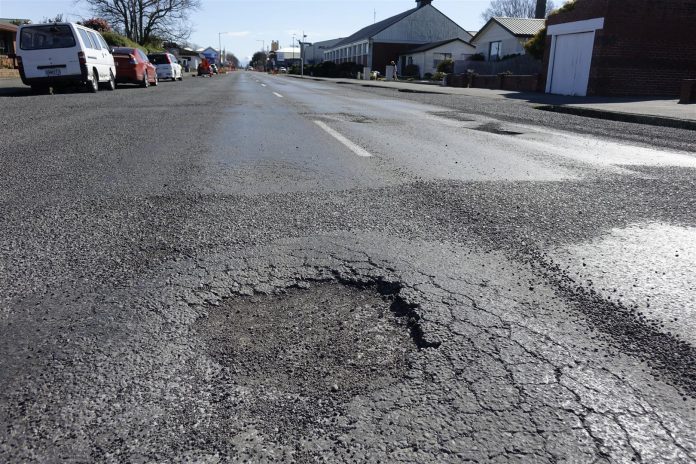The Ashburton District Council was given some perspective on the pothole problem plaguing Mid Canterbury when roading contractor HEB gave a presentation at last week’s council meeting.
HEB general manager of roading Harry Alderson described it as a ‘‘pothole invasion’’ that has spread across the country.
Some of the reasons included increased significant weather events, roads not designed for today’s traffic volumes and historic under-investment in pavement maintenance.
Mr Alderson said potholes were formed by vehicles forcing water down through cracks in the pavement, causing failures.
‘‘Water in combination with traffic means holes appear,’’ he said.
Mid Canterbury has had significantly wetter two years resulting in saturated pavements.
Mr Alderson said the HEB team has completed an all-faults assessment, ‘‘taking a really good look across the entire network and identifying anything that’s wrong with it to inform the decision making on how best to respond.’’
There were 12,652 potholes repaired district-wide in 2022.
The Ashburton District has a road network of 1500 km’s and the average rehabilitation quantity over the past 12 years was 9.3km, of the 60km a year that needed to be improved.
Mayor Neil Brown asked how many of the repaired potholes were repeat jobs.
HEB Ashburton contract manager James Faber said it would be hard to put a percentage on how many were repeats but went on to give an overview of the process.
‘‘We’ve invested quite a bit in the mix that we used, we’ve done some trials and found that the mix we currently use is by far the best.
‘‘It comes at two and half times the cost of what you would normally buy and fill the potholes, to avoid repeats we have stuck with that and it shows really good results.’’
Mr Faber said they did not use a hot mix as it was a safety risk.
‘‘The issue with hot mix is it breaks up and then clumps becomes dangerous on the road … we’re open to using hot mix but it is a safety risk.’’
Cr Leen Braam questioned why the roads in the Netherlands seem to last a lot longer than roads in New Zealand, but Mr Alderson said roads in Europe used thicker layers of asphalt compared to the just 2mm of bitumen put on rural New Zealand roads.
‘‘That’s the affordable solution to 95% of New Zealand roads … we’re relying on that 2mm to keep it waterproof, so we ask a hell of a lot and that’s because the population base we have to contribute and fund it means that’s our most effective whole of life investment.
‘‘It would be three to four times the cost to build the roads like they do in Europe,’’ he said.
Mr Brown said it pointed to underfunding.
‘‘We know its underfunded, you know its underfunded, you have the statistics there, how much road need to be resealed every year, how much should be rehabilitated, we’re way under where it should be.’’
He said funding was something they had been taking up with the Government without result.
Pothole invasion explained
- Advertisement -




